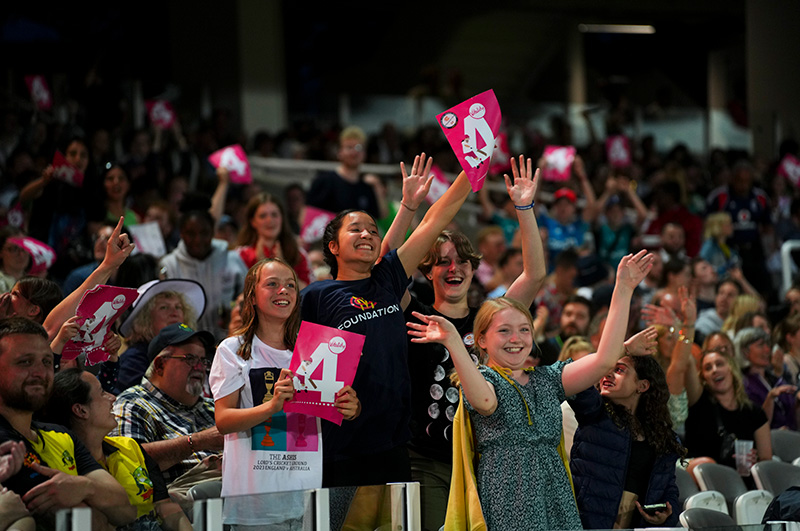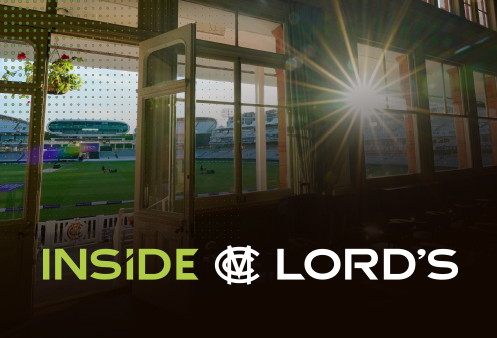Ajmal Shahzad appointed as Head Coach of MCC
Read story
Come here to find all the information you need to help you plan your visit to the Home of Cricket, the latest news from the Ground and to book your event.

We’ve got a wide variety of formats covered with an exciting line up of matches to get your cricket fix.
Whether you like red or white ball, domestic or international, or men’s or women’s cricket, Lord’s will have the perfect cricket experience for you, your family and friends.

Marylebone Cricket Club is the world’s most active cricket club, the owner of Lord’s Ground and the guardian of the Laws of the game. Find out more about the history of MCC, our work in the Community and the famous Lord's Museum.
FIND OUT MORE

Step closer. Your new digital platform at the Home of Cricket.
Subscribe now for early access to selected international matches, exclusive content, coaching masterclasses and many more discounts and offers.
Your access to Lord's like never before.

Marylebone Cricket Club is one of the World's most active Cricket Clubs, the owner of Lord's Ground and the Guardian of the Laws and Spirit of the Game.
With around 200 full time staff members covering a wide range of sectors - from IT to Chefs to Pavilion Stewards - there is a role at the Home of Cricket for everyone.

Posted: 10 January 2019
Renegades and Australia batsman Marcus Harris skied a ball up in the air, presenting Ben Cutting with what looked like a simple chance.
But Cutting made a mess of it, leading to the third umpire determining that Harris was not out.
Was that the right decision? And why was it made? MCC's Laws department has the answers.
So firstly, what happened? Well, as you can see from the video here, the ball dropped through Cutting’s hands and landed on his face, drawing rather a lot of blood.
Cutting falls to the ground and the ball lands on his chest, at which point he picks it up and flicks it away with his hand and it lands on the ground. So, is that out?
Is this a catch or not?@bowlologist would like @hershybru to adjudicate 😅#BBL08 pic.twitter.com/kaNkULOOan
— #7Cricket (@7Cricket) January 10, 2019
Law 33.1 states:
The striker is out Caught if a ball delivered by the bowler, not being a No ball, touches his/her bat without having previously been in contact with any fielder, and is subsequently held by a fielder as a fair catch, as described in 33.2 and 33.3, before it touches the ground.
So far, so good. The ball was delivered, was not a No ball, touched the bat.
So the only question is whether it was ‘held by a fielder as a fair catch’ before it touched the ground. But what is a fair catch?
Law 33.2.2.1 gives the simplest definition of this type of catch.
It states:
a catch will be fair if…
the ball is held in the hand or hands of a fielder, even if the hand holding the ball is touching the ground, or is hugged to the body, or lodges in the external protective equipment worn by a fielder, or lodges accidentally in a fielder’s clothing.
The important thing to note here is that a catch can be taken if the ball is hugged to the body, as well as caught in the hands.
The final, and most important, piece of Law to look at with regards to this incident is Law 33.3, which states:
The act of making a catch shall start from the time when the ball first comes into contact with a fielder’s person and shall end when a fielder obtains complete control over both the ball and his/her own movement.
This is key. When Cutting lands on the floor, he is clearly not in control of the ball or his own movement. But does he gain control over both those things before he releases the ball?
Let’s look at the ball first.
It comes to rest on his chest, he then picks it up and throws it away. There is an argument that it might slip out of his hand slightly, but given he is able to hug it to his body and then dispose of it, this is probably enough evidence of control.
But, does that control come after Cutting has control of his movement?
Cutting’s legs are certainly still moving when he releases the ball – but movement does not, in and of itself, mean a lack of control.
The question is: could Cutting have stopped his movement if he had wanted to? (Similarly a fielder who was on his/her feet would not have to be stationary after taking a running catch for it to be completed – but they would have to be in a position where they could stop if they wanted to.)
There is no easy answer.
As this photo shows below, the fielder is in such an unusual position that it is extremely difficult for any umpire to judge if he is, or is not, in control of his movement. And if an umpire is not certain, they cannot give it out. What is important to note is that this is a judgement call.
What is important to note is that this is a judgement call.
The Laws are clear that control is necessary, but judging that control is, to an extent, subjective.
The umpires decided it was Not Out – and they are not wrong.
But another umpire, on another day, might go the opposite way.
So, what do you think?